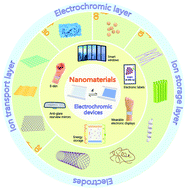Advances in nanomaterials for electrochromic devices†
Abstract
Electrochromic devices (ECDs) have been regarded as promising candidates for energy-saving smart windows, next-generation displays and wearable electronics due to their significant benefits of simple and adjustable structures, low power consumption, flexible and stretchable features, and eye-friendly modes for displays. However, there are many existing issues waiting to be solved such as durability, reversibility and inadequate switching performances. These insurmountable technical bottlenecks significantly slow down the commercialization of next-generation ECDs. Nanomaterials with superior active reaction surface area have played indispensable roles in optimizing heterogeneous electron transfer and homogeneous ion transfer for ECDs and other optoelectronic devices. In recent years, with the joint efforts of various outstanding research teams, new kinds and methods for nanomaterials to fabricate ECDs with excellent performances have been rapidly developing. This review highlights the latest exciting results regarding the design and application of new and unique nanomaterials for each layer of ECDs. Meanwhile, the structures, mechanisms, features and preparation of the reported nanomaterials to improve the electrochromic properties have been discussed in detail. In addition, the remaining challenges and corresponding strategies of this field are also proposed. Hopefully, this review can inspire more and more researchers to enrich the nanomaterials for ECDs and other related fields to overcome faced technical barriers by innovative means and promote industrialization of ECDs and other optoelectronic technologies.



 Please wait while we load your content...
Please wait while we load your content...